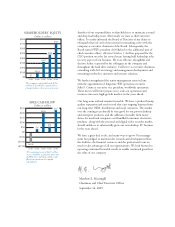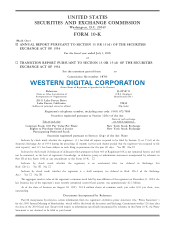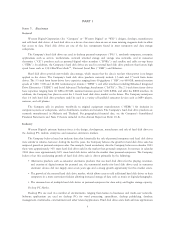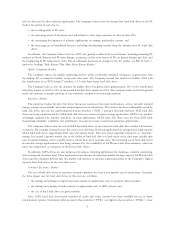Western Digital 2005 Annual Report Download - page 13
Download and view the complete annual report
Please find page 13 of the 2005 Western Digital annual report below. You can navigate through the pages in the report by either clicking on the pages listed below, or by using the keyword search tool below to find specific information within the annual report.""Internal data transfer rate'' Ì the sustained rate at which data is transferred to and from the disk Ì
commonly expressed in megabits per second. One megabit is equal to one million bits.
""Spindle rotational speed'' Ì the nominal rotational speed of the disks inside the hard disk drive Ì
commonly expressed in RPMs, revolutions per minute or latency. While the reference to spindle rotational speeds of
5400, 7200 and 10,000 RPMs is commonly used, in some cases these speeds are approximations.
""Acoustics'' Ì the sound power that is emitted while the hard disk drive is operating Ì commonly expressed
in decibels.
All of the Company's hard disk drive products employ similar technology. The main components of the hard disk
drive are the head disk assembly and the printed circuit board. The head disk assembly includes the head, media
(disks), head positioning mechanism (actuator) and spindle motor. These components are contained in a hard base
plate protective package in a contamination-controlled environment. The printed circuit board includes both standard
and custom integrated circuits, an interface connector to the host computer and a power connector.
The head disk assembly is comprised of one or more disks positioned around a spindle hub that rotates the disks by
a spindle motor. Disks are made of a smooth substrate to which a thin coating of magnetic materials is applied. Each disk
has a head suspended directly above it, which can read data from or write data to the spinning disk.
The integrated circuits on the printed circuit board typically include a drive interface and a controller. The drive
interface receives instructions from the computer, while the controller directs the flow of data to or from the disks and
controls the heads. The location of data on each disk is logically maintained in concentric tracks that are divided into
sectors. The computer sends instructions to the controller to read data from or write data to the disks based on logical
track and sector locations. Guided by instructions from the controller, the head stack assembly is pivoted and swung
across the disk by a head actuator or motor until it reaches the selected track of a disk, where the data is recorded or
retrieved.
Industry standard interfaces are utilized to allow the hard disk drive to communicate with the computer. Currently,
the primary interface for desktop PCs is EIDE, and the primary interface for enterprise systems is SCSI. As computer
performance continues to improve, the hard disk drive will need to deliver information faster than these interfaces can
handle. The Company believes that the desktop PC industry plans to transition to higher speed interfaces, such as SATA,
to handle the higher data transfer rates. The Company currently offers its WD Caviar products, 7200 RPM drives with
the SATA interface and featuring capacities as large as 400 GB. These products are designed for the PC, workstation,
server, and external storage markets. The Company believes that SATA is also becoming a more popular interface in the
enterprise market. Western Digital currently offers its WD Raptor hard disk drive, a 10,000 RPM enterprise-class drive
with the SATA interface, and the WD Caviar RE2 and RE hard disk drives, 7200 RPM drives manufactured to
enterprise-class standards and available with a SATA interface.
Storage capacity of the hard disk drive, as manufactured by Western Digital, is determined by the number of disks
and each disk's areal density, which is a measure of the amount of data that can be stored on the recording surface of the
disk. The higher the areal density, the more information can be stored on a single platter. As the areal density increases,
fewer disks and/or heads are required to achieve a given drive capacity, thus reducing product costs through reduced
component requirements.
Head technology is one of the variables affecting areal density. Historically, there have been rapid technological
changes resulting in several generations of head technology in a relatively short period of time. However, in recent years
the time has lengthened between changes in generations of head technology. Currently, the desktop hard disk drive
industry uses giant magnetoresistive head technology, which allows significantly higher storage capacities than the
previously utilized thin-film head technology. All of the Company's hard disk drive product offerings currently employ
giant magnetoresistive head technology. In addition, significant development efforts have been undertaken across the
industry to implement perpendicular recording technology. The Company anticipates using perpendicular recording
heads in certain products in the future.
The Western Digital product line generally leverages a common platform for various products within product
families with different capacities to serve the differing market needs. This platform strategy results in commonality of
components across different products within product families and, in some cases, across product families, which reduces
7
























